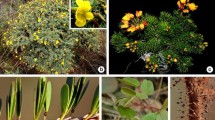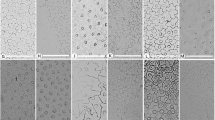Abstract
The current classification systems recognize Salacioideae as a monophyletic group within Celastraceae. Nonetheless, some divergences exist for genera: in some cases, most species of the subfamily have been included in only two genera; in others, these genera have been subdivided. This study characterizes the leaf anatomy of 31 species of the subfamily Salacioideae as a contribution to identifying them through features that may also help distinguish among genera. Cross-sections of the median region of the leaf blade and of the petiole and dissociated and macerated epidermis were analyzed. Taxonomically relevant anatomical characters include the type of crystals in the parenchymatous tissue (monocrystals in Cheiloclinium and druses in other genera); the presence of laticifers in Cheiloclinium and Tontelea only; the variable form of the petiole vascular system among studied species; the type of stomata (cyclocytic with two concentric circles of subsidiary cells in P. dulcis; anomocytic in T. attenuata, T. fluminensis, and T. leptophylla; laterocytic in C. anomalum and C. hippocrateoides; and ciclocytic in the other species); the sinuosity of the anticlinal walls of the epidermal cells (sinuous in Cheiloclinium and Peritassa, except P. laevigata, and in S. arborea, S. insignis, S. mosenii, S. nemerosa, and S. opacifolia, and straight in all other studied species); the presence of crystalliferous idioblasts in the epidermis of P. dulcis, P. flaviflora, and P. mexiae; and the presence, form, and disposition of sclereids in the leaf blade, which is a highly variable character among the studied species.













Similar content being viewed by others
References
Alquini Y, Bona C, Boeger MRT, Costa CG, Barros CF (2003) Epiderme. In: Appezzato-da-Glória B, Carmello-Guerreiro SM (eds) Anatomia vegetal. Editora UFV, Universidade Federal de Viçosa, Viçosa, pp 87–107
Balan Menon PK (1964) Perupok wood. Revision of nomenclature and classification. Malayan For 27:18–21
Barthlott W (1981) Epidermal and seed surface characters of plants: systematic applicability and some evolutionary aspects. Nord J Bot 1:345–355. doi:10.1111/j.1756-1051.1981.tb00704.x
Coughenour JM, Simmons MP, Lombardi JA, Cappa JJ (2010) Phylogeny of Celastraceae subfamily Salacioideae and tribe Lophopetaleae inferred from morphological characters and nuclear and plastid genes. Syst Bot 35(2):358–367
Den Hartog RM, Tholen V, Bass P (1978) Epidermal characters of the Celastraceae sensu lato. Acta Bot Neerl 27:355–388
Esau K (1977) Anatomy of seed plants, 2nd edn. Wiley, New York
Fahn A (1990) Plant anatomy, 4th edn. Pergamon Press, New York
Farrell BD, Dussourd DE, Mitter C (1991) Escalation of plant defense: do latex and resin canals spur plant diversification? Am Nat 138(4):881–900. doi:10.1086/285258
Fernandez MGV, Morales JB, Angeles G (1998) Anatomical studies on Hippocratea excelsa (Hippocrateaceae). Acta Bot Mex 43:7–21
Foster A (1949) Pratical plant anatomy. Van Nostrand, New York
Franceschinelli EV, Yamamoto K (1993) Taxonomic use of leaf anatomical caracters in the genus Simarouba Aublet (Simaroubaceae). Flora 188:117–124
Gomes SMA, Silva EAM, Lombardi JA, Azevedo AA, Vale FHA (2005) Anatomia foliar como subsídio à taxonomia de Hippocrateoideae (Celastraceae) no sudeste do Brazil. Acta Bot Bras 19(4):945–961. doi:10.1590/S0102-33062005000400029
Görts-van Rijn ARA, Mennega AMW (1994) Hippocrateaceae. In: Görts-van Rijn ARA (ed) Flora of the Guianas 16. Koeltz Scientific, Königstein, pp 110–128
Hall JB, Lock JM (1975) Use of vegetative characters in the identification of species of Salacia (Celastraceae). Boissiera 24:331–338
Hou D (1963) Celastraceae. In: van Steenis CGGJ (ed) Flora Malesiana I, vol 6. Flora Malesiana Foundation, Leyden, pp 227–291
Hou D (1969) Pólen of Sarawakodendron (Celastraceae) and some related genera with notes on techniques. Blumea 17:97–120
Jain DK, Singh V (1974) Occurrence of giant stomata in Celastraceae and Convolvulaceae. Curr Sci 5:170
Jansen WT, Baas P (1973) Comparative leaf anatomy of Kokoona and Lophopetalum (Celastraceae). Blumea 21:153–178
Johansen DA (1940) Plant microtechnique. McGraw Hill, New York
Kraus JE, Arduin M (1997) Manual Básico de Métodos em Morfologia Vegetal. Universidade Federal Rural do Rio de Janeiro, Rio de Janeiro
Kurz S (1870) On some new or imperfectly known Indian plants. J Asiat Soc Beng 39(II):73
Menezes NL, Silva DC, Pinna GFAM (2003) Folha. In: Appezzato-da-Glória B, Carmello-Guerreiro SM (eds) Anatomia vegetal. Editora UFV, Universidade Federal de Viçosa, Viçosa, pp 303–324
Mennega AMW (1983) Notes on new world Hippocrateae (Fam. Celastraceae) II—a new species in Hemiangium. Acta Bot Neerl 32(5/6):427–430
Mennega AMW (1997) Wood anatomy of the Hippocrateoideae (Celastraceae). IAWAJ 18(4):331–368
Metcalfe CR (1967) Distribution of latex in the plant kingdom. Econ Bot 21:115–127
Metcalfe CR, Chalk L (1979) Anatomy of the dicotyledons, vol 1: systematic anatomy of the leaf and stem. Oxford University Press, New York
Metcalfe CR, Chalk L (1983) Anatomy of the dicotyledons, vol 2: wood structure and conclusion of the general introduction. Oxford University Press, New York
Monje PV, Baran EJ (2002) Characterization of calcium oxalates generated as biominerals in cacti. Plant Physiol 128:707–713. doi:10.1104/pp010630
Nakata PA (2002) Calcium oxalate crystal morphology. Trends Plant Sci 7(7):324. doi:10.1016/S1360-1385(02)02285-9
Pant DD, Kidwai PF (1965) Epidermal structure and stomatal ontogeny in some Celastraceae. New Phytol 65:288–295. doi:10.1111/j.1469-8137.1966.tb06364.x
Peyritisch J (1878) Hippocrateaceae. In: Martius CFP, Eichler AG (eds) Flora Braziliensis, vol 11, no 1. Frid Fleischer, Lipsiae, pp 125–164
Prychid CJ, Rudall PJ (1999) Calcium oxalate crystals in monocotyledons: a review of their structure and systematics. Ann Bot 84:725–739. doi:10.1006/anbo.1999.0975
Rehfous L (1914) Les stomates des Célastracées. Soc Bot Genéve sér 2 VI(1):13–18
Robson N (1965) New and little known species from the flora Zambesiaca area. XVI. Taxonomic and nomenclatural notes on Celastraceae. Bol Soc Brot 2(39):5–55
Salatino A, Montenegro G, Salatino MLF (1986) Microscopia eletrônica de varredura de superfícies foliares de espécies lenhosas do cerrado. Revta Brazil Bot 9:117–124
Sass JE (1951) Botanical microtechnique, 2nd edn. Iowa State College Press, Ames
Simmons MP, Hendin JP (1999) Relationships and morphological character change among genera of Celastraceae sensu latu (including Hippocrateaceae). Ann Missouri Bot Gard 86(3):723–757
Simmons MP, Clevinger CC, Savolainen V, Archer RH, Mathews S, Doyle JJ (2001a) Phylogeny of the Celastraceae inferred from phytochrome B gene sequence and morphology. Am J Bot 88:313–325
Simmons MP, Savolainen V, Clevinger CC, Archer RH, Davis JI (2001b) Phylogeny of the Celastraceae inferred from 26S nuclear ribosomal DNA, phytochrome B, rbcl, atpB, and morphology. Mol Phylogenet Evol 19:353–366. doi:10.1006/mpev.2001.0937
Sitholey RV, Pandey YN (1970) Giant stomata. Ann Bot 35:641–642
Smith AC (1940) The American species of Hippocrateaceae. Brittonia 3:341–555. doi:10.2307/2804624
Smith LB, Robinson HE (1971) Hippocrateáceas. In: Reitz R (ed) Flora ilustrada catarinense. Herbário Barbosa Rodrigues, Itajaí, pp 1–33
Smith FH, Smith EC (1942) Anatomy of the inferior ovary of Darbia. Am J Bot 29:464–471. doi:10.2307/2437312
Solereder H (1908) Systematic anatomy of the dicotyledons: a handbook for laboratories of pure and applied botany. Clarendon Press, Oxford
Stace CA (1965) Cuticular studies as an aid to plant taxonomy. Bull Br Mus (Nat Hist) Bot 4(1):1–78
Vannucci AL, Rezende MH (2003) Anatomia vegetal: noções básicas. Edição do Autor, Goiânia
Vega AS, Castro MA, Anderson WR (2002) Occurence and phylogenetic significance of latex in the Malpighiaceae. Am J Bot 89(11):1725–1729. doi:10.3732/ajb.89.11.1725
Zona S (2004) Raphides in palm embryos and their systematic distribution. Ann Bot 93:415–421. doi:10.1093/aob/mch060
Acknowledgments
We thanks CNPq-Conselho Nacional de Desenvolvimento Científico e Tecnológico, for Sandra M. A. Gomes Doctor Fellowship, and Julio A. Lombardi for the Research Fellowship grants (nº 523026/96-0, 300220/2003-0, and 306395/2006-1). We would also like to thank the reviewers Louis Ronse De Craene and Mark P. Simmons, who critically reexamined his manuscript.
Author information
Authors and Affiliations
Corresponding author
Rights and permissions
About this article
Cite this article
Gomes, S.M.A., Lombardi, J.A. Leaf anatomy as a contribution to the taxonomy of Salacioideae N.Hallé ex Thorne & Reveal (Celastraceae). Plant Syst Evol 289, 13–33 (2010). https://doi.org/10.1007/s00606-010-0328-8
Received:
Accepted:
Published:
Issue Date:
DOI: https://doi.org/10.1007/s00606-010-0328-8




